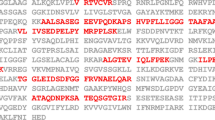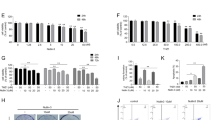Abstract
TRAIL induces apoptosis in many malignant cell types. In this study, we used the human papilloma virus (HPV) 16 E6 protein as a molecular tool to probe the TRAIL pathway in HCT116 colon carcinoma cells and U2OS osteosarcoma cells. Intriguingly, we found that while E6 protected HCT116 cells from TRAIL, U2OS cells expressing E6 remained sensitive to TRAIL. Furthermore, silencing FADD and procaspase-8 expression with siRNA did not prevent TRAIL-induced apoptosis in U2OS cells. However, siBid provided significant protection from TRAIL, and the cleavage kinetics of Bid and caspase-8 revealed that Bid was cleaved prior to the activation of caspase-8. Cathepsin B activity in U2OS cells was significantly activated shortly after exposure to TRAIL, and the cathepsin B inhibitor, CA074Me, inhibited both TRAIL- and anti-DR5-mediated apoptosis and delayed the cleavage of Bid. These findings suggest that TRAIL activates a pathway dependent on Bid, but largely independent of FADD and caspase-8, in U2OS cells.









Similar content being viewed by others
References
MacFarlane M, Ahmad M, Srinivasula SM, Fernandes-Alnemri T, Cohen GM, Alnemri ES (1997) Identification and molecular cloning of two novel receptors for the cytotoxic ligand TRAIL. J Biol Chem 272:25417–25420
Pan G, O’Rourke K, Chinnaiyan AM et al (1997) The receptor for the cytotoxic ligand TRAIL. Science 276:111–113
Pan G, Ni J, Wei YF, Yu G, Gentz R, Dixit VM (1997) An antagonist decoy receptor and a death domain-containing receptor for TRAIL. Science 277:815–818
Sheridan JP, Marsters SA, Pitti RM et al (1997) Control of TRAIL-induced apoptosis by a family of signaling and decoy receptors. Science 277:818–821
Chaudhary PM, Eby M, Jasmin A, Bookwalter A, Murray J, Hood L (1997) Death receptor 5, a new member of the TNFR family, and DR4 induce FADD-dependent apoptosis and activate the NF-kappaB pathway. Immunity 7:821–830
Schneider P, Bodmer JL, Thome M, Hofmann K, Holler N, Tschopp J (1997) Characterization of two receptors for TRAIL. FEBS Lett 416:329–334
Yeh W-C, de la Pompa JL, McCurrach ME, Shu H-B, Elia AJ, Shahinian A, Ng M, Wakeham A, Khoo W, Mitchell K, El-Deiry WS, Lowe SW, Goeddel DV, Mak TW (1998) FADD: Essential for embryo development and signaling from some, but not all, inducers of apoptosis. Science 279:1954–1958
Sprick MR, Weigand MA, Rieser E, Rauch CT, Juo P, Blenis J, Krammer PH, Walczak H (2000) FADD/MORT1 and caspase-8 are recruited to TRAIL receptors 1and 2 and are essential for apoptosis mediated by TRAIL receptor 2. Immunity 12:599–609
Kischkel FC, Lawrence DA, Chuntharapai A, Schow P, Kim KJ, Ashkenazi A (2000) Apo2L/TRAIL-dependent recruitment of endogenous FADD and caspase-8 to death receptors 4 and 5. Immunity 12:611–620
Thomas LR, Henson A, Reed JC, Salsbury FR, Thorburn A (2004) Direct binding of Fas-associated death domain (FADD) to the tumor necrosis factor-related apoptosis-inducing ligand receptor DR5 is regulated by the death effector domain of FADD. J Biol Chem 279:32780–32785
Almasan A, Ashkenazi A (2003) Apo2L/TRAIL: apoptosis signaling, biology, and potential for cancer therapy. Cytokine Growth Factor Rev 14:337–348
Barnhart BC, Alappat EC, Peter ME (2003) The CD95 type I/type II model. Semin Immunol 15:185–193
Green DR (2003) The suicide in the thymus, a twisted trail. Nat Immunol 4:207–208
Herr I, Wilhelm D, Meyer E, Jeremias I, Angel P, Debatin KM (1999) JNK/SAPK activity contributes to TRAIL-induced apoptosis. Cell Death Differ 6:130–135
Vivo C, Liu W, Broaddus VC (2003) c-Jun N-terminal kinase contributes to apoptotic synergy induced by tumor necrosis factor-related apoptosis-inducing ligand plus DNA damage in chemoresistant, p53 inactive mesothelioma cells. J Biol Chem 278:25461–25467
Voelkel-Johnson C, Hannun YA, El-Zawahry A (2005) Resistance to TRAIL is associated with defects in ceramide signaling that can be overcome by exogenous C6-ceramide without requiring down-regulation of cellular FLICE inhibitory protein. Mol Cancer Ther 4:1320–1327
Petak I, Vernes R, Szucs KS et al (2003) A caspase-8-independent component in TRAIL/Apo-2L-induced cell death in human rhabdomyosarcoma cells. Cell Death Differ 10:729– 739
Liu J, Guo Q, Chen B, Yu Y, Lu H, Li YY (2006) Cathepsin B and its interacting proteins, bikunin and TSRC1, correlate with TNF-induced apoptosis of ovarian cancer cells OV-90. FEBS Lett 580:245–250
Heinrich M, Neumeyer J, Jakob M et al (2004) Cathepsin D links TNF-induced acid sphingomyelinase to Bid-mediated caspase-9 and -3 activation. Cell Death Differ 11:550–563
Nagaraj NS, Vigneswaran N, Zacharias W (2006) Cathepsin B mediates TRAIL-induced apoptosis in oral cancer cells. J Cancer Res Clin Oncol 132:171–183
Garnett TO, Filippova M, Duerksen-Hughes PJ (2006) Accelerated degradation of FADD and procaspase 8 in cells expressing human papilloma virus 16 E6 impairs TRAIL-mediated apoptosis. Cell Death Differ 13:1915–1926
Filippova M, Parkhurst L, Duerksen-Hughes PJ (2004) The human papillomavirus 16 E6 protein binds to Fas-associated death domain and protects cells from Fas-triggered apoptosis. J Biol Chem 279:25729–25744
Carrasco RA, Stamm NB, Patel BK (2003) One-step cellular caspase-3/7 assay. Biotechniques 34:1064–1067
Filippova M, Song H, Connolly JL, Dermody TS, Duerksen-Hughes PJ (2002) The human papillomavirus 16 E6 protein binds to tumor necrosis factor (TNF) R1 and protects cells from TNF-induced apoptosis. J Biol Chem 277:21730– 21739
Tang DG, Porter AT (1996) Apoptosis: A current molecular analysis. Pathol Oncol Res 2:117–131
Filippova M, Brown-Bryan TA, Casiano CA, Duerksen-Hughes PJ (2005) The human papillomavirus 16 E6 protein can either protect or further sensitize cells to TNF: effect of dose. Cell Death Differ 12:1622–1635
Nagata S, Golstein P (1995) The fas death factor. Science 267:1449
Yonehara S, Ishii A, Yonehara M (1989) A cell-killing monoclonal antibody (anti-Fas) to a cell surface antigen co-downregulated with the receptor of tumor necrosis factor. J Exp Med 169:1747– 1756
Deng Y, Ren X, Yang L, Lin Y, Wu X (2003) A JNK-dependent pathway is required for TNFalpha-induced apoptosis. Cell 115:61–70
Ghafourifar P, Klein SD, Schucht O et al (1999) Ceramide induces cytochrome c release from isolated mitochondria. Importance of mitochondrial redox state. J Biol Chem 274:6080–6084
Bennett BL, Sasaki DT, Murray BW et al (2001) SP600125, an anthrapyrazolone inhibitor of Jun N-terminal kinase. Proc Natl Acad Sci USA 98:13681–13686
Yang J, Yu Y, Sun S, Duerksen-Hughes PJ (2004) Ceramide and other sphingolipids in cellular responses. Cell Biochem Biophys 40:323–350
Guicciardi ME, Leist M, Gores GJ (2004) Lysosomes in cell death. Oncogene 23:2881–2890
Cirman T, Oresic K, Mazovec GD et al (2004) Selective disruption of lysosomes in HeLa cells triggers apoptosis mediated by cleavage of Bid by multiple papain-like lysosomal cathepsins. J Biol Chem 279:3578–3587
Kuang AA, Diehl GE, Zhang J, Winoto A (2000) FADD is required for DR4- and DR5-mediated apoptosis: lack of trail-induced apoptosis in FADD-deficient mouse embryonic fibroblasts. J Biol Chem 275:25065–25068
Hersey P, Zhang XD (2001) How melanoma cells evade trail-induced apoptosis. Nat Rev Cancer 1:142–150
Zhang XD, Zhang XY, Gray CP, Nguyen T, Hersey P (2001) Tumor necrosis factor-related apoptosis-inducing ligand-induced apoptosis of human melanoma is regulated by smac/DIABLO release from mitochondria. Cancer Res 61:7339–7348
Zhang L, Fang B (2005) Mechanisms of resistance to TRAIL-induced apoptosis in cancer. Cancer Gene Ther 12:228–237
Maundrell K, Antonsson B, Magnenat E et al (1997) Bcl-2 undergoes phosphorylation by c-Jun N-terminal kinase/stress-activated protein kinases in the presence of the constitutively active GTP-binding protein Rac1. J Biol Chem 272:25238–25242
Kharbanda S, Saxena S, Yoshida K et al (2000) Translocation of SAPK/JNK to mitochondria and interaction with Bcl-x(L) in response to DNA damage. J Biol Chem 275:322–327
Rincon M, Whitmarsh A, Yang DD et al (1998) The JNK pathway regulates the In vivo deletion of immature CD4(+)CD8(+) thymocytes. J Exp Med 188:1817–1830
Sabapathy K, Hu Y, Kallunki T et al (1999) JNK2 is required for efficient T-cell activation and apoptosis but not for normal lymphocyte development. Curr Biol 9:116–125
Walsh CM, Wen BG, Chinnaiyan AM (1998) O’Rourke K, Dixit VM, Hedrick SM. A role for FADD in T cell activation and development. Immunity 8:439–449
Smith KG, Strasser A, Vaux DL (1996) CrmA expression in T lymphocytes of transgenic mice inhibits CD95 (Fas/APO-1)-transduced apoptosis, but does not cause lymphadenopathy or autoimmune disease. Embo J 15:5167–5176
Martin S, Phillips DC, Szekely-Szucs K, Elghazi L, Desmots F, Houghton JA (2005) Cyclooxygenase-2 inhibition sensitizes human colon carcinoma cells to TRAIL-induced apoptosis through clustering of DR5 and concentrating death-inducing signaling complex components into ceramide-enriched caveolae. Cancer Res 65:11447–11458
Koblinski JE, Ahram M, Sloane BF (2000) Unraveling the role of proteases in cancer. Clin Chim Acta; Int J Clin Chem 291:113–135
Bogyo M, Verhelst S, Bellingard-Dubouchaud V, Toba S, Greenbaum D (2000) Selective targeting of lysosomal cysteine proteases with radiolabeled electrophilic substrate analogs. Chem Biol 7:27–38
Acknowledgments
This work was supported by NIH Grant 1 R01 CA-095461 (PDH), the Ruth L. Kirschstein National Service Award Individual Fellowship 1 F31 CA113650-01A1 (TG), and by NIH award 2R25 GM060507-05. In addition, we thank Dr. Carl Ware (La Jolla Institute for Allergy and Immunology) for the pcDNA-FADD-encoding plasmid.
Author information
Authors and Affiliations
Corresponding author
Rights and permissions
About this article
Cite this article
Garnett, T.O., Filippova, M. & Duerksen-Hughes, P.J. Bid is cleaved upstream of caspase-8 activation during TRAIL-mediated apoptosis in human osteosarcoma cells. Apoptosis 12, 1299–1315 (2007). https://doi.org/10.1007/s10495-007-0058-8
Published:
Issue Date:
DOI: https://doi.org/10.1007/s10495-007-0058-8




